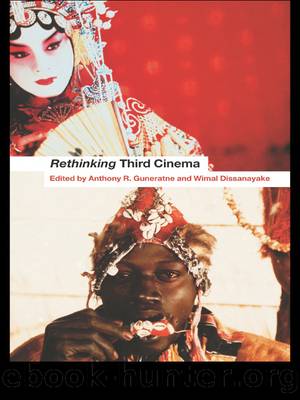Rethinking Third Cinema by Dissanayake Wimal;Guneratne Anthony;

Author:Dissanayake, Wimal;Guneratne, Anthony;
Language: eng
Format: epub
Publisher: Taylor & Francis Group
Published: 2023-02-09T00:00:00+00:00
Geographic repositionings
Lita Stanticâs 1992 Un muro de silencio/A Wall of Silence serves as an even more emphatic model of the dynamic interplay of cinematic/cultural spaces in the global system as theorized by Jameson. An Argentine-Mexican co-production with Channel 4, London, the film marks the directorial debut of Stantic, a woman closely connected with Argentine film productions of resistance (Bemberg, Hector Olivera). A key figure in the territorialization of Argentine cinema over the past two decades, she has shown herself to be both independent âworking beyond the alliances that have formed the usual male-dominated commercial patterns of Argentine film â and creative â continually seeking to redefine the progressive political position of Latin American film as a critical intervention in regional cultural politics.
Un muro de silencio is a striking demonstration of Stanticâs formidable directorial talents. From its opening frame, the film effects a temporal distanciation by looking back on the Dirty War from a vantage of approximately a decade after the events it interrogates. The story focuses on two women. Silvia Massini (Ofelia Medina)12 is the wife of one of the disappeared; she has now begun a new life with her adolescent daughter, Elisa, and her second husband, Ernesto. Kate Benson (Vanessa Redgrave) is a British filmmaker who has come to Buenos Aires to make a documentary about Silvia, based on the script by Bruno (Lautaro Murúa), a professor of political science with whom Silvia had earlier had an affair. Silvia refuses to see Kate, but, mysteriously, as the filmmaker rehearses scenes from Brunoâs script, Silvia begins to relive moments in her own past life, which textually become intertwined with Kateâs version. Thus, the two women who are seen ârepresenting Argentine historyâ become psychic and narrational doubles.
Vanessa Redgrave in the role of Kate mirrors her off-screen celebrity persona as the defender of unpopular minority causes, such as those of the Palestinians and the IRA. That intertextual identity helps to naturalize the fictional character of Kate Benson, giving it an implicit moral authority never verbalized in the script but clearly the point of the actressâs presence in the film. In the face of the âwall of silenceâ she encounters in her contacts with Argentines regarding their recent past, Kate is transformed into an agent of historical inquiry. She doesnât understand recent political history and must interrogate it in ways that cast the film in a pedagogical light, as one which educates its audience through that process of historical inquiry.
For the Argentine viewer, the Redgrave-Kate Benson character becomes the site for a peculiar kind of âre-learningâ about the nation in which the very act of questioning poses a counter-narrative to the clichés of official cultural discourse about Argentine history. Because Kate is not merely an uninformed Argentine inquiring into her national history, as was the case with Alicia, the heroine of Puenzoâs film, her presence effectively serves as a stand-in for the foreign audience of the film. This, however, turns out to be more than merely a convenient ploy to justify the global commercial aspirations of the film.
Download
This site does not store any files on its server. We only index and link to content provided by other sites. Please contact the content providers to delete copyright contents if any and email us, we'll remove relevant links or contents immediately.
Verus Israel: Study of the Relations Between Christians and Jews in the Roman Empire, AD 135-425 by Marcel Simon(550)
Infocracy by Byung-Chul Han(532)
Caesar Rules: The Emperor in the Changing Roman World (c. 50 BC â AD 565) by Olivier Hekster(527)
Europe, Strategy and Armed Forces by Sven Biscop Jo Coelmont(477)
Banned in the U.S.A. : A Reference Guide to Book Censorship in Schools and Public Libraries by Herbert N. Foerstel(444)
Reading Colonial Japan by Mason Michele;Lee Helen;(441)
Give Me Liberty, Seventh Edition by Foner Eric & DuVal Kathleen & McGirr Lisa(435)
The Roman World 44 BC-AD 180 by Martin Goodman(434)
DS001-THE MAN OF BRONZE by J.R.A(419)
The Dangerous Life and Ideas of Diogenes the Cynic by Jean-Manuel Roubineau(417)
The Oxford History of World War II by Richard Overy(414)
Introducing Christian Ethics by Samuel Wells and Ben Quash with Rebekah Eklund(408)
Imperial Rome AD 193 - 284 by Ando Clifford(407)
american english file 1 student book 3rd edition by Unknown(403)
Basic japanese A grammar and workbook by Unknown(381)
Literary Mathematics by Michael Gavin;(373)
Language Hacking Mandarin by Benny Lewis & Dr. Licheng Gu(351)
How to Reach the 9.0 in IELTS Academic Reading by IELTS Medical(333)
The Oxford History of the Renaissance by Campbell Gordon;(331)
